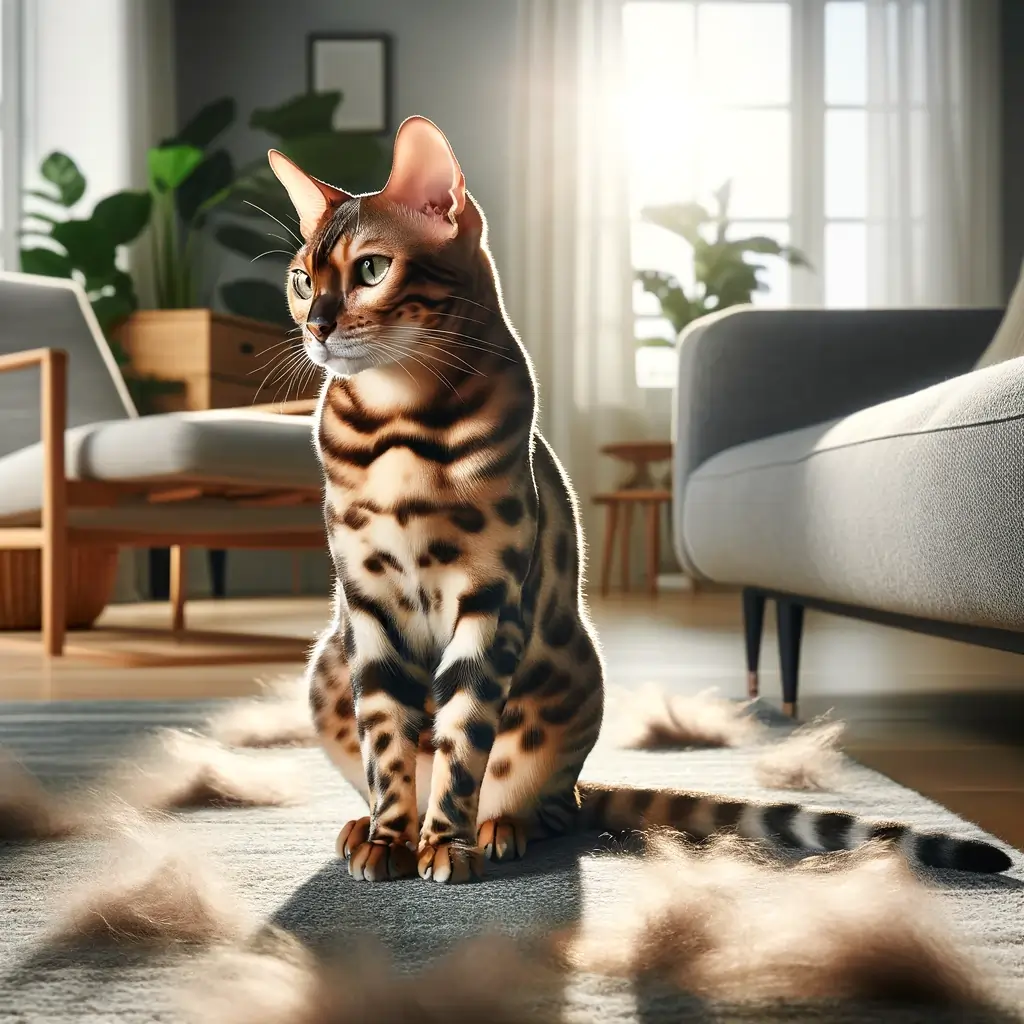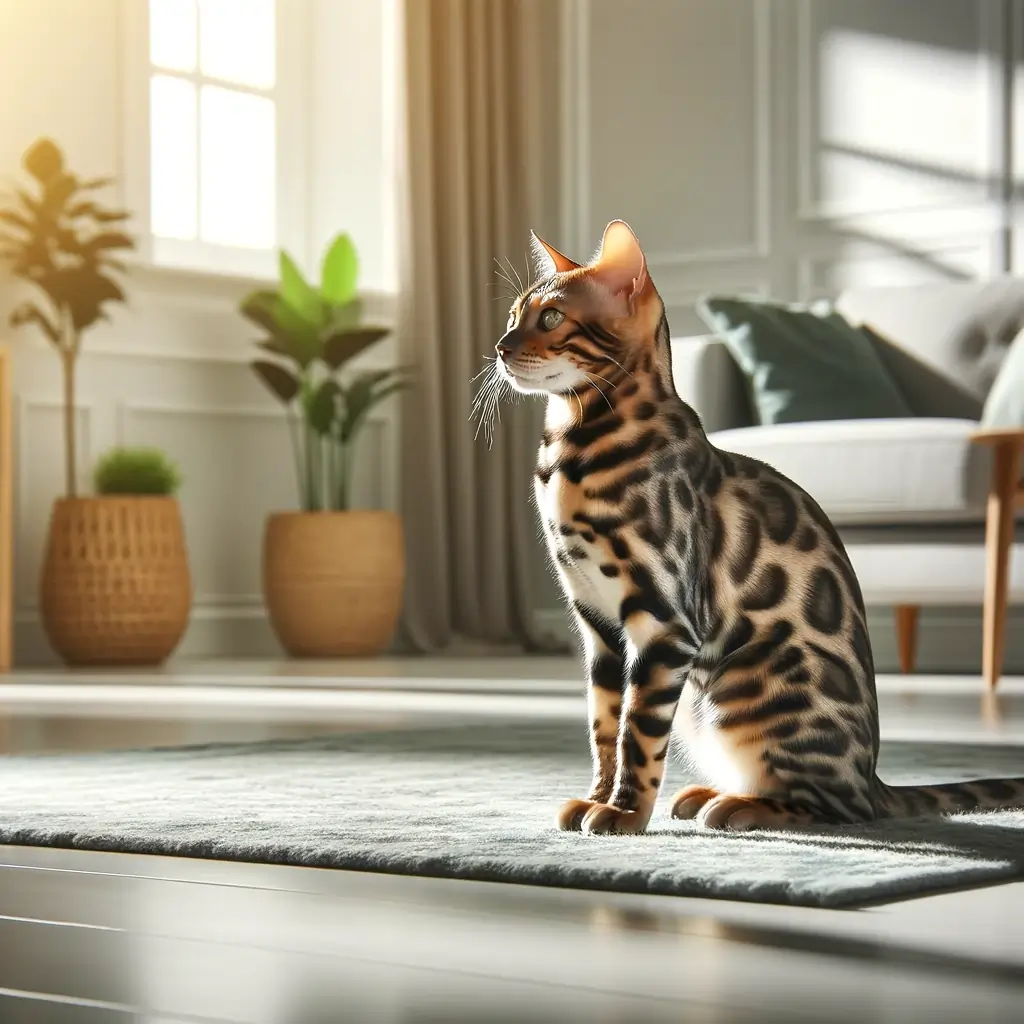In this article, we will explore the shedding habits of Bengal cats and uncover the truth about whether they shed a lot. We will address common concerns, such as why some Bengal cats may shed more than others and whether they are hypoallergenic. By the end, you’ll have a better understanding of how to care for your Bengal cat’s coat.
Shedding Habits of Bengal Cats
Bengal cats are a remarkable breed known for their striking coat, which resembles that of a leopard or tiger. However, it’s essential to understand that the shedding habits of Bengal cats can vary. While they may not shed as much as long-haired breeds, they are not completely hypoallergenic despite their pelt-like coat.
Domesticated from their Asian leopard cat ancestors, Bengal cats have inherited their breed’s unique coat characteristics, including dense and short fur that closely resembles a pelt. This distinctive coat consists of hairs with patterns, such as spots or marbling, creating an exquisite look.
Although Bengal cats shed less compared to long-haired breeds, they are not entirely exempt from shedding. Factors such as genetics, grooming habits, health, and environmental conditions can contribute to variations in shedding patterns.
To understand the shedding habits of Bengal cats, it is crucial to consider their breed and genetic makeup. The protein structure of their fur and the way it is attached to their skin play a vital role in shedding. While regular grooming and a protein-rich diet can help minimize shedding, individual Bengal cats may still experience occasional periods of excessive shedding.
The shedding habits of Bengal cats can be influenced by factors such as genetics, nutrition, grooming, and overall health. While they may shed less than other breeds, it’s important to be prepared for occasional shedding and take proper care of their coat.
Factors that Influence Shedding
Several factors can influence a Bengal cat’s shedding habits. While they may shed less than other breeds, it’s important to note that Bengal cats are not considered hypoallergenic. Even though they may shed minimally, they can still produce dander, which may trigger allergic reactions in sensitive individuals.
To reduce the amount of stray hair and dander in your home and minimize the impact on allergies, regular grooming and cleaning are essential. Taking the time to groom your Bengal cat not only helps to keep their coat healthy and shiny but also removes loose hair and reduces the spread of allergenic substances.
Grooming your Bengal cat can be an enjoyable bonding experience. Using a brush specifically designed for shedding cats can help remove loose fur and dander effectively. Additionally, consider using hypoallergenic wipes or sprays to further reduce allergens on your cat’s coat.
It’s also crucial to keep your living environment clean by vacuuming regularly, especially in areas where your Bengal cat spends the most time. This helps remove any stray hairs and dander that may be present, further minimizing the potential for allergic reactions.
While Bengal cats shed less and may be less allergenic compared to some other cat breeds, it’s important to note that individuals with severe cat allergies may still experience an allergic reaction. If you or someone in your household has cat allergies, it’s best to consult with a healthcare professional or allergist for appropriate measures and precautions.
Understanding Bengal Cat’s Coat Maintenance
Bengal cats are known for their stunning and silky coats, but it’s important to understand that they do shed. While their short fur may not be as noticeable as long-haired breeds, regular coat maintenance is still necessary to keep shedding under control. By being conscious of your cat’s diet and ensuring they receive the proper nutrients, you can help maintain a healthy coat and minimize shedding.
One of the key aspects of Bengal cat coat maintenance is regular brushing. Brushing your cat’s coat not only helps remove excess hair but also prevents it from spreading throughout your home. This is especially important considering that their sleek fur can sometimes mask heavy shedding.
In addition to regular brushing, it’s essential to be aware of any potential health problems that may contribute to excessive shedding. Providing a balanced and nutrient-rich diet is crucial for the overall well-being of your Bengal cat’s coat. Being conscious of your cat’s diet can help ensure they receive the necessary nutrients for a healthy and glossy coat.
Remember, Bengal cats may have different shedding habits, and some individuals may shed more or less than others. Pay attention to any changes in shedding habits and consult with a veterinarian if you notice any significant concerns.
Tips for Bengal Cat Coat Maintenance:
- Regularly brush your Bengal cat’s coat to remove excess hair and prevent it from spreading throughout your home.
- Provide a balanced and nutrient-rich diet to promote a healthy and glossy coat.
- Observe any changes in shedding habits and consult with a veterinarian if necessary.
| Benefits of Bengal Cat Coat Maintenance | Why It’s Important |
|---|---|
| Minimizes shedding | Regular brushing helps remove excess hair and prevents it from spreading around your home. |
| Maintains a healthy coat | A balanced and nutrient-rich diet contributes to a glossy and healthy Bengal cat coat. |
| Prevents matting and tangling | Regular brushing helps prevent the formation of mats and tangles in your cat’s fur. |

Seasonal Shedding and Behavior Changes
Bengal cats, like other domestic cats, may experience seasonal shedding. As winter turns to spring, they may shed excessively to prepare for warmer weather. During this time, you may notice changes in your cat’s behavior, such as increased playfulness.
It is crucial to keep an eye out for any unusual patches or balding, as excessive shedding may be a sign of underlying health problems. If you notice any concerns, it is best to consult with a veterinarian.
Conclusion
In conclusion, Bengal cats do shed, but they may shed less than other breeds. Their short fur and sleek coat make them less likely to have excessive shedding. However, it is important to note that Bengal cats are not completely hypoallergenic and can still trigger allergic reactions in sensitive individuals.
To help reduce shedding and keep your Bengal cat healthy, regular grooming is essential. Brushing their coat regularly can help remove excess hair and minimize shedding. Additionally, providing them with a balanced and nutritious diet is important for maintaining a healthy coat.
If you notice any concerns about your cat’s shedding or overall health, it is always recommended to consult with a veterinarian for professional advice. Taking proper care of your Bengal cat’s coat will not only help manage shedding but also contribute to their overall well-being. Remember, a happy and healthy cat is a delight to both the cat owner and the entire family.
Q: Do Bengal Cats Shed A Lot?
A: Bengal cats are known for shedding less compared to other breeds. While they still shed like any other cat, their fine coat requires minimal grooming to keep shedding under control.
Q: Are Bengal Cats Hypoallergenic?
A: Bengal cats are not considered hypoallergenic, but some people with allergies may find that they have fewer reactions to Bengal cats. It’s best to spend time with a Bengal cat before bringing one home if you have allergies.
Q: How can I Manage Bengal Cat Shedding?
A: Regular grooming is key to managing shedding in Bengal cats. Brushing them weekly can help remove loose fur and reduce the amount of hair they shed around your home.
Q: What Should I Feed my Bengal Cat to Reduce Shedding?
A: A high-quality diet that provides essential nutrients can help reduce shedding in Bengal cats. Consult your vet to ensure your cat is getting the right nutrients for a healthy coat.
Q: Do Bengal Kittens Shed Differently than Adult Bengals?
A: Bengal kittens may shed less than adult Bengals as their coat is still developing. As they grow, their shedding patterns may change, so be prepared for adjustments in grooming routine.
Q: How Can I Minimize Cat Allergies with a Bengal Cat?
A: Keeping your Bengal cat well-groomed, providing a healthy diet, and keeping your home clean can help minimize allergic reactions to cat dander. Consult with your vet for additional advice.

Hey guys, My name is Simon Smith. I’m from Canada and live near Victoria
I live with my sweet family and have 20+ Ragdolls of different types. I love them as my own children. My profession is as a hotel manager.
I love to keep Ragdolls and grow their breeder case. I have 7 years of experience.
I’m an expert in cat care. So, I’m here to provide you with new information about my cats daily. This is my personal blog website, so I request that you kindly visit our site daily.
If you’re a Ragdolls lover and you have any questions or confusion about cats, text me on the Contact Us page or Gmail.
Thank u
